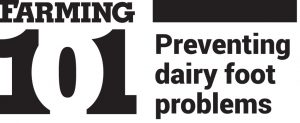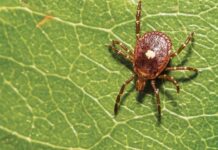Last week, we helped you identify six common foot problems found in dairy cattle. This week, we share five tips from the Penn State Extension Dairy Team on managing and preventing dairy cow foot problems.

1Scoring lameness
Preventative management in a dairy herd requires knowing the prevalence of lameness and the animals affected. This can be determined using a lameness scoring system.
- Score 1, normal — cow stands and walks with level back posture; gait is normal.
- Score 2, mildly lame — cow stands with a level back posture, but develops an arched back posture while walking; gait is normal.
- Score 3, moderately lame — An arched back posture is evident while standing and walking. Gait is affected, uses short strides with one or more limbs.
- Score 4, lame — arched back posture is always evident and gait is one deliberate step at a time; cow favors one or more limbs or feet.
- Score 5, severe lameness — cow additionally demonstrates an inability or extreme reluctance to bear weight on one or more of her limbs or feet.
2Nutrition
There are several areas in nutrition that can help reduce the risk of foot problems: carbohydrates, protein, trace minerals, and vitamins. Formulating the ideal ration to maintain good hoof health is not always enough.
Nutrition should be weighed along with other factors in preventing bovine lameness from being a herd problem.
3Behavior and stress
Dairy cows should be allowed to lie 10 to 14 hours per day. Lying time can be reduced because of poorly designed housing or stalls that are uncomfortable or too few in number. Prolonged standing causes sore feet that can become susceptible to disease.
Exercise is important for stimulating blood flow through the feet and keeping the tissues healthy, however too much exercise and concussion on concrete floors can cause trauma and mechanical damage. Overcrowding will cause heifers to wait to eat at the bunk when space becomes available. This will cause her to engorge three to four times a day instead of the normal 13 to 14 meals a day.
Any management practice that imposes stress on animals — vaccinations, transportation, reduced exercise, sudden changes in rations — can deplete the body’s nutrient reserves. Stress can reduce the animal’s resistance to disease and can be a factor in lameness.
4Stall comfort
Cows should have adequate stall space to allow reclining and ruminating for about 10 to 14 hours per day. Stall should be sized for the cow — about seven to eight feet long for large cows.
Soft bedding is essential — sand is optimal, providing comfort and traction. An earthen base with shredded tires covered with polyethylene sheets also works in providing a cushioned base. Make sure material is non-abrasive.
5Hoof trimming
Regular hoof trimming may increase the functional life of a dairy cow by a lactation. Correctly trimming a cow’s feet can give the claw stability and enable the cow to distribute weight equally between the claw. It is recommended to trim feet at least once to twice a year.
Sources: Prevention and Control of Foot Problems in Dairy Cows, Virginia A. Ishler, Penn State Extension Dairy Team.
(Farm and Dairy is featuring a series of “101” columns throughout the year to help young and beginning farmers master farm living. From finances to management to machinery repair and animal care, farmers do it all.)
More Farming 101 columns:
- 6 common foot problems found in dairy cows
- Recognize, prevent heat stress in dairy cattle
- How to monitor your dairy herd
- How to start your own dairy farm
- 5 tips for sun safety in the field
- Employing youth for the summer
- What to do if a hay fire occurs
- How to prevent hay fires
- How to extend the life of your fence
- 10 safety tips for installing electric fences
- How to chose the right fence for your farm
- How to create a fencing plan
- 7 steps for easy sprayer calibration
- Prepare for planting season, Part 2: Calibration
- Prepare for planting season, Part 1: The Basics
- 7 tips to improve security on your farm
- 5 tips to protect your farmland
- 3 measures to deal with severe farm debt
- How to buy time to catch up on farm debt
- 6 tips to manage income on the farm
- 5 tips to recognize and deal with farm stress
- How to prepare a livestock birthing kit
- 5 tips for marketing your farm
- How to develop farm mission, vision statements
- 5 tips for setting farm goals
- 2 types of livestock insurance policies
- 6 things you need to know about WFRP plans
- 3 basics of crop insurance
- How does liability insurance work on the farm?
- Why do I need farm insurance?
- How to understand and use Ohio’s CAUV
- How to utilize the Pa. Clean and Green Act
- 9 tips for filing farm taxes
- 8 reasons record keeping for taxes is essential
- 5 tips for post-harvest storage
- 7 tips for family meetings on the farm
- 4 tips for balancing your farm and family
- 4 tips for communicating on the family farm
- 4 tips for firing an employee
- 6 tips for keeping good farm help
- 4 tips for recruiting farm labor
- 5 general farm labor laws
- 4 tips for employing minors
- 4 tips for PTO safety
- 5 things young farmers should know about finances
- The farm balance sheet
- 5 items for your farm’s cash flow statement
- Personal and business records: Keep them separate
- What to include in your farm business plan
- How to approach a lender: Tips for getting a farm loan
- How to use microloans to get your farm started
- Saving for the future: 6 tips for young farmers
- How to create a farm safety kit
- 5 tips for child safety on the farm
- 4 tips for transporting livestock
- 5 ways to better understand tractor stability
- 6 farm equipment hacks













Wonderful post! Keep up the good writing.